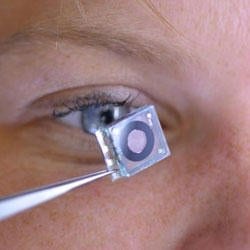
For hundreds of years, optical devices like telescopes and microscopes have relied on solid lenses that slide up and down to magnify and to focus.
To tune how much light is received, conventional devices use mechanical contraptions like the blades that form the adjustable aperture in cameras. To meet demands for ever smaller imaging systems, researchers are working to create entirely unconventional ways of focusing light. In pursuit of this vision, engineers from the Univ. of Freiburg in Germany have built a novel type of imaging system inspired by the elegance and relative mechanical simplicity of the human eye. The technology may one day lead to new imaging instruments and microscopes for use in medicine and scientific research, such as devices for detecting early signs of skin cancer or early visual cues for food spoilage.
The new imaging system is the first to demonstrate the imaging capabilities of some of these unusual focusing techniques by replacing conventional, solid lenses with the combination of a malleable lens and a liquid iris-like component. And, the researchers report, their device focuses light almost as well as its biological counterpart in people. They describe their new imaging system in a paper published today in The Optical Society’s (OSA) journal Optics Letters.
Though the image processing that happens in the human brain and eye is complex, the mechanical apparatus is relatively simple. It consists of muscles that deform a stretchable lens to change the focal length, the distance between the lens and the point at which rays of light are brought to a focus. The eye’s iris opens and closes to control the amount of light that can pass through the lens.
But as engineers try to shrink the size and expand the capabilities of these instruments, the imaging systems they create become overly complex and expensive. Instead of using complicated mechanisms that require moving parts to tune the focus and adjust the aperture, the Freiburg researchers looked to the eye.
“What we’re doing now is a completely different means of doing the tuning,” said Hans Zappe, the Gisela and Erwin Sick Professor of Micro-optics at the University of Freiburg and coauthor of the paper.
For their new device, the researchers used two imaging elements that they had demonstrated previously but had never combined into a single system. They made a lens of silicone surrounded by several miniaturized motors that adjust the focus by deforming the lens.
“You can squeeze and stretch it just like your eye squeezes and stretches its lens to adjust its focal length,” Zappe explained.
In front of the lens they included an iris-like component, which contains two liquids enclosed in a single flat chamber. One liquid is opaque and surrounds the clear liquid, forming what looks like a donut of black ink. Because the clear liquid is oil-based while the dark liquid is water-based, they stay separated. And since both liquids have exactly the same density, they remain in place even if you shake or rotate the device.
Applying an electrical voltage to these liquids changes some of their properties, such as the way a droplet beads up on a surface. This behavior, called electrowetting, allowed the researchers to manipulate the liquid, expanding and contracting the dark ring to let in more or less light through the clear liquid at the center.
The Latest Bing News on:
Imaging system
- vivo and Zeiss forge new R&D partnership for Imaging solutionson May 8, 2024 at 10:03 pm
vivo and Zeiss have signed a new agreement to extend their joint research and development efforts. This collaboration aims to push the boundaries of cooperation further and foster sustainable ...
- EQS-News: STEMMER IMAGING: expectedly challenging market environment in Q1 2024 - positive signals in order intake – Full-year forecast confirmedon May 8, 2024 at 12:00 am
STEMMER IMAGING is the leading international systems house for machine vision technology. With a background of all-round engineering expertise, STEMMER IMAGING delivers the entire spectrum of machine ...
- Vascular Imaging Systems Market Shifts: Navigating Changing Consumer Preferenceson May 6, 2024 at 11:51 pm
Growing prevalence of cardiovascular diseases and cancer are driving the Global Vascular Imaging Systems ...
- Researchers unveil single-shot and complete polarization imaging system using metasurfaceson May 2, 2024 at 8:03 am
Think of all the information we get based on how an object interacts with wavelengths of light—aka color. Color can tell us if food is safe to eat or if a piece of metal is hot. Color is an important ...
- United Imaging secures FDA clearance for uMR Jupiter 5T MRI systemon May 1, 2024 at 11:22 pm
United Imaging, a medical imaging and radiotherapy equipment maker, has secured the US Food and Drug Administration (FDA) clearance for its uMR Jupiter 5 tesla (5T) MRI system. It is claimed to be the ...
- Global Cell Imaging Systems Market Peak Performance Market Size’s Projection to Reach New Heightson April 30, 2024 at 6:00 pm
The Cell Imaging Systems market has witnessed substantial growth and transformation. From generating $$ Million USD in revenue in 2016, it escalated to $$ Million USD in 2020, projecting to reach $$ ...
- Launch of New, In Vivo Imaging Softwareon April 30, 2024 at 10:05 am
TUCSON, AZ — Spectral Instruments Imaging, the performance leader in preclinical optical imaging solutions, is excited to announce the launch of Aura 4.5, the latest version of its in vivo imaging ...
- £3 million for the world's first imaging system could help develop better medicine, batteries and solar cellson April 30, 2024 at 3:08 am
The creation of a first-of-its-kind imaging system at the University of Surrey could help the UK lead a revolution in materials sciences. The new facility promises a better understanding of the ...
- 'Seeing the invisible': New tech enables deep tissue imaging during surgeryon April 29, 2024 at 5:45 pm
Hyperspectral imaging (HSI) is a state-of-the-art imaging technique useful for determining the composition of a variety of objects. Specifically, over-thousand-nanometer (OTN) HSI is particularly ...
- Airborne single-photon lidar system achieves high-resolution 3D imagingon April 25, 2024 at 7:00 am
Researchers have developed a compact and lightweight single-photon airborne lidar system that can acquire high-resolution 3D images with a low-power laser. This advance could make single-photon lidar ...
The Latest Google Headlines on:
Imaging system
[google_news title=”” keyword=”Imaging system” num_posts=”10″ blurb_length=”0″ show_thumb=”left”]
The Latest Bing News on:
New imaging system
- vivo and Zeiss forge new R&D partnership for Imaging solutionson May 8, 2024 at 10:03 pm
vivo and Zeiss have signed a new agreement to extend their joint research and development efforts. This collaboration aims to push the boundaries of cooperation further and foster sustainable ...
- Yunu Delivers a New Imaging Workflow Paradigm for Investigator-Initiated Trialson May 8, 2024 at 12:00 am
Yunu's aim is to ensure breakthrough therapies are accessible to everyone by unifying medical imaging insights and connecting clinical communities. With thousands of clinical trials relying on the ...
- ARVO 2024: AI may open new frontiers in vision researchon May 7, 2024 at 12:17 pm
Four poster presentations at the Association for Research in Vision and Ophthalmology’s (ARVO) 2024 Annual Meeting in Seattle, Washington, demonstrate the possibilities.
- Vascular Imaging Systems Market Shifts: Navigating Changing Consumer Preferenceson May 6, 2024 at 11:51 pm
Growing prevalence of cardiovascular diseases and cancer are driving the Global Vascular Imaging Systems ...
- New Harvard Technology Paves the Way for Advanced Machine Visionon May 6, 2024 at 3:21 pm
Scientists have developed a compact, single-shot, and complete polarization imaging system using metasurfaces. Think of all the information we get based on how an object interacts with wavelengths of ...
- Global Cell Imaging Systems Market Peak Performance Market Size’s Projection to Reach New Heightson April 30, 2024 at 6:00 pm
The Cell Imaging Systems market has witnessed substantial growth and transformation. From generating $$ Million USD in revenue in 2016, it escalated to $$ Million USD in 2020, projecting to reach $$ ...
- 'Seeing the invisible': New tech enables deep tissue imaging during surgeryon April 29, 2024 at 5:45 pm
Hyperspectral imaging (HSI) is a state-of-the-art imaging technique useful for determining the composition of a variety of objects. Specifically, over-thousand-nanometer (OTN) HSI is particularly ...
- New tech enables deep tissue imaging during surgeryon April 28, 2024 at 5:00 pm
Additionally, it enables measurement using light previously unseen in industrial applications, potentially creating new areas of ... nm hyperspectral imaging rigid-scope system using ...
- New imaging technique provides a much closer look at fibril assemblieson April 26, 2024 at 10:47 pm
A new imaging technique developed by engineers at Washington University in St. Louis can give scientists a much closer look at fibril assemblies, stacks of peptides like amyloid beta, most notably ...
- Airborne single-photon lidar system achieves high-resolution 3D imagingon April 25, 2024 at 7:00 am
Researchers have developed a compact and lightweight single-photon airborne lidar system that can acquire high-resolution 3D images with a low-power laser. This advance could make single-photon lidar ...
The Latest Google Headlines on:
New imaging system
[google_news title=”” keyword=”new imaging system” num_posts=”10″ blurb_length=”0″ show_thumb=”left”]










